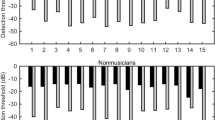Abstract
Tumors in primary sensory area are challenging to remove without causing a neurological deficit, especially in musicians who present complex neuronal networks. Indeed, in this kind of patients, somatosensory evoked potentials (SSEPs) are not plenty. We describe our experience for sensory and proprioception preservation in a professional clarinet player undergoing surgery for a right parietal glioblastoma. The patient underwent surgery for a right parietal glioblastoma. Intraoperative monitoring and awake surgery while playing instrument, were performed. During resection, intraoperative stimulation caused a transient impairment of left hand movements, without SSEPs alteration. The resection was stopped anytime there was a movement impairment. We obtained a gross total tumor resection. Patient did not present neurological deficits. Standard neurophysiological monitoring is fundamental but cannot be sufficient. More complex strategies of monitoring, such as awake surgery and playing an instrument could be of help for preserving complex sensory-motor functions.




Similar content being viewed by others
References
Shinoura N, Suzuki Y, Yamada R, Kodama T, Takahashi M, Yagi K (2005) Fibers connecting the primary motor and sensory areas play a role in grasp stability of the hand. Neuroimage 25:936–941
Yamada K, Nagakane Y, Yoshikawa K, Kizu O, Ito H, Kubota T et al (2007) Somatotopic organization of thalamocortical projection fibers as assessed with MR tractography. Radiology 242:840–845
Shinoura N, Suzuki Y, Yoshida M, Yamada R, Tabei Y, Saito K et al (2009) Assessment of the corona radiata sensory tract using awake surgery and tractography. J Clin Neurosci 16:764–770
Gaser C, Schlaug G (2003) Brain structures differ between musicians and non-musicians. J Neurosci 23:9240–9245
Riva M, Casarotti A, Comi A, Pessina F, Bello L (2016) Brain and music: an intraoperative stimulation mapping study of a professional opera singer. World Neurosurg 93:486.e13–486.e18
Atherton RP, Chrobak QM, Rauscher FH, Karst AT, Hanson MD, Steinert SW et al (2018) Shared processing of language and music. Exp Psychol 65:40–48
Peretz I, Zatorre RJ (2005) Brain organization for music processing. Annu Rev Psychol 56:89–114
Munte TF, Altenmuller E, Jancke L (2002) The musician's brain as a model of neuroplasticity. Nat Rev Neurosci 3:473–478
Elbert T, Pantev C, Wienbruch C, Rockstroh B, Taub E (1995) Increased cortical representation of the fingers of the left hand in string players. Science 270:305–307
Hoffmann N, Radev Y, Koch E, Petersohn U, Steiner G, Kirsch M (2018) Intraoperative mapping of the sensory cortex by time-resolved thermal imaging. Biomed Tech (Berl) 63:567–572
Kombos T, Suess O, Kern B et al (1999) Comparison between monopolar and bipolar electrical stimulation of the motor cortex. Acta Neurochir (Wien) 141:1295–1301
Spena G, Schucht P, Seidel K et al (2017) Brain tumors in eloquent areas: A European multicenter survey of intraoperative mapping techniques, intraoperative seizures occurrence, and antiepileptic drug prophylaxis. Neurosurg Rev 40:287–298
Taniguchi M, Cedzich C, Taniguchi M, Cedzich C, Schramm J (1993) Modification of cortical stimulation for motor evoked potentials under general anesthesia: technical description. Neurosurgery 32(2):219–226
Keles G, Lundin DA, Lamborn KR, Chang EF, Ojemann G, Berger MS (2004) Intraoperative subcortical stimulation mapping for hemispheric perirolandic gliomas located within or adjacent to the descending motor pathways: evaluation of morbidity and assessment of functional outcome in 294 patients. J Neurosurg 100(3):369–375
Szelényi A, Senft C, Jardan M, Forster MT, Franz K, Seifert V, Vatter H (2011) Intra-operative subcortical electrical stimulation: a comparison of two methods. Clin Neurophysiol 122(7):1470–1475 (Epub 2011 Feb 16)
Author information
Authors and Affiliations
Corresponding author
Ethics declarations
Conflict of interest
The authors certify that they have no conflict of interest and no affiliations with or involvement in any organization or entity with any financial interest or non-financial interest in the subject matter or materials discussed in this manuscript.
Additional information
Publisher's Note
Springer Nature remains neutral with regard to jurisdictional claims in published maps and institutional affiliations.
Electronic supplementary material
Below is the link to the electronic supplementary material.
Video 1: tumor resection is ongoing under continuous stimulation and neurophysiological monitoring. During stimulation of the posterior part of the surgical field, patient complaints left hand movement impairment. Once the stimulation is stopped, the disturbance disappears and she restarts playing correctly. SEPs did not present any change. (MP4 24167 kb)
Rights and permissions
About this article
Cite this article
Scerrati, A., Mongardi, L., Cavallo, M.A. et al. Awake surgery for skills preservation during a sensory area tumor resection in a clarinet player. Acta Neurol Belg 121, 1235–1239 (2021). https://doi.org/10.1007/s13760-020-01368-5
Received:
Accepted:
Published:
Issue Date:
DOI: https://doi.org/10.1007/s13760-020-01368-5




